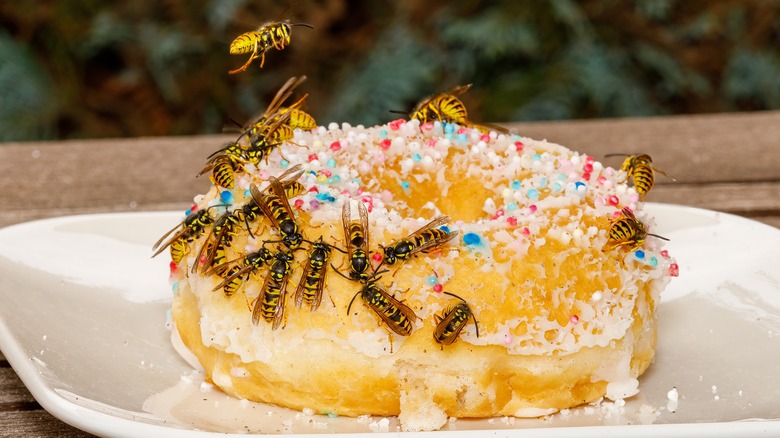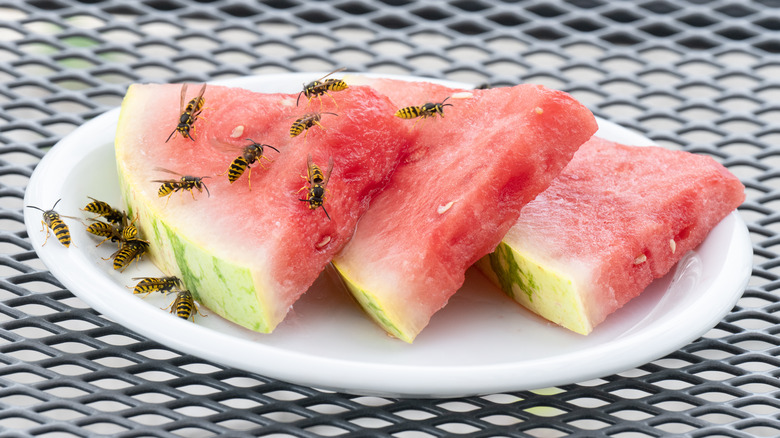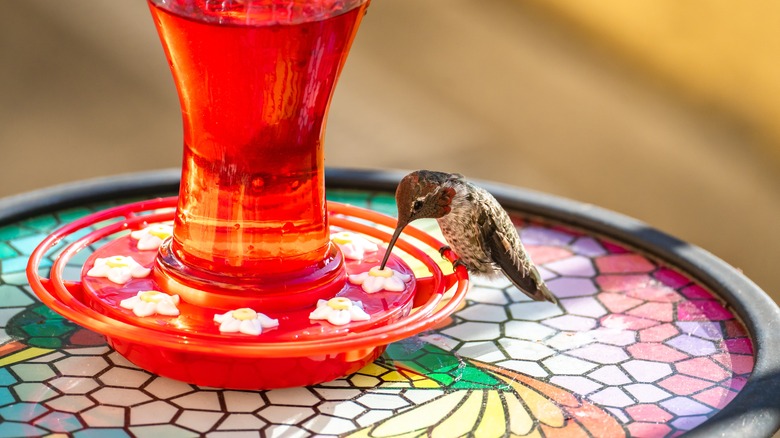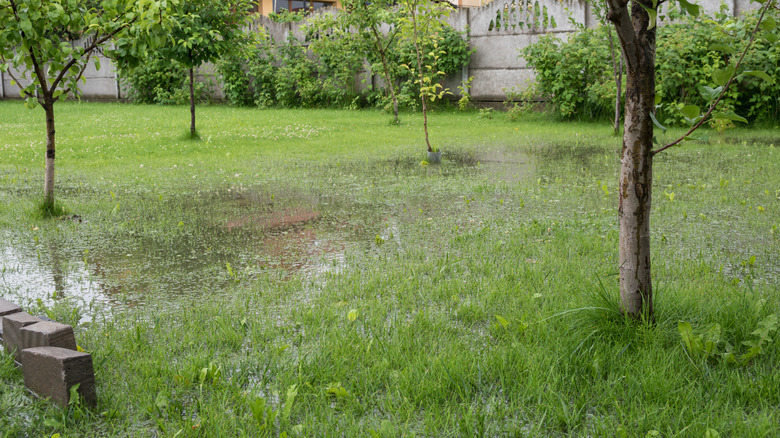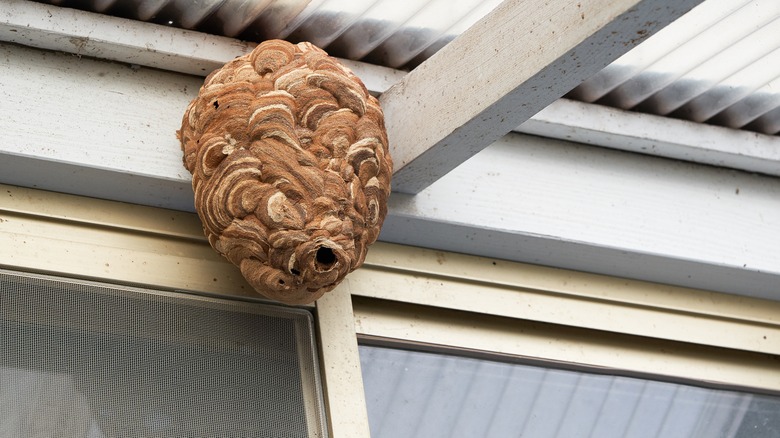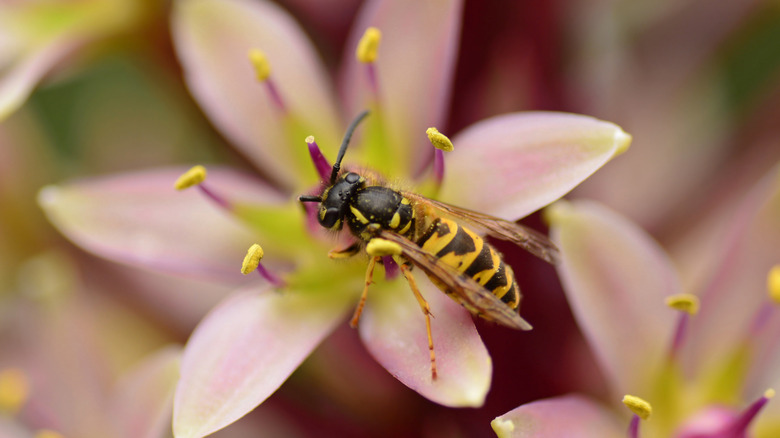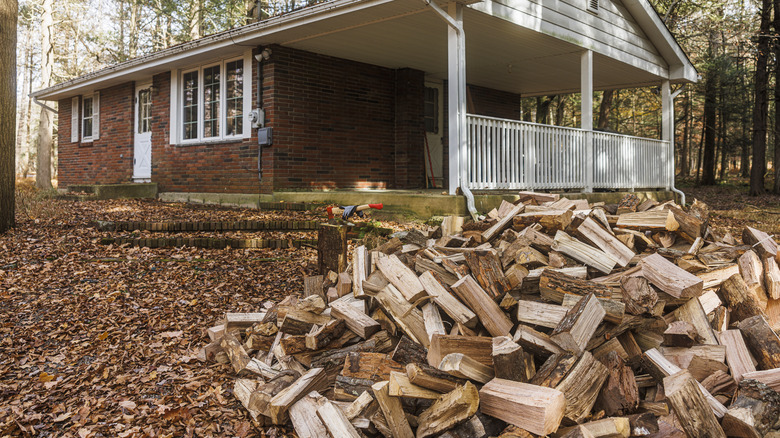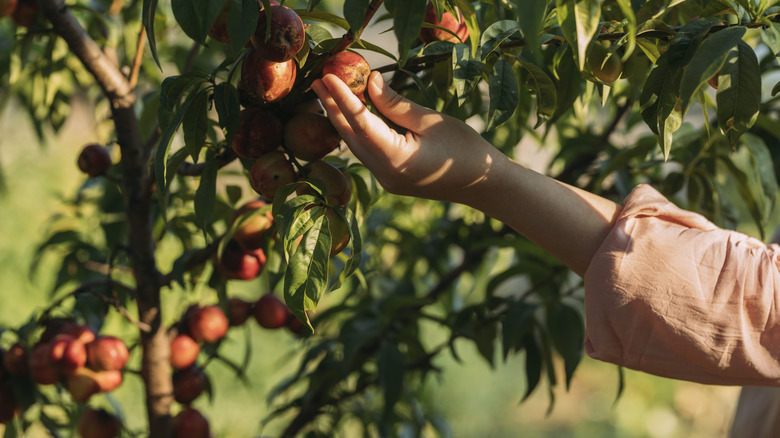7 Things That Are Attracting Wasps To Your Home And Garden
Wasps, despite their notorious reputation as stingers and pests, play a crucial role in ecosystems around the world. But that doesn't mean that you want them hanging around your home and garden all the time. Yes, they can help pollinate the beautiful flowers growing in your yard. Some species can also eat other pests that might harm your plants like aphids and flies. But these qualities don't make their stings hurt any less! In some cases, you or someone in your family might even be allergic to wasps, making keeping them away even more important for everyone's safety. While it's impossible to keep wild insects out of an outdoor environment 100% of the time, there are things you can do to make it less likely that wasps are going to show up.
These seven things top the list of ways you are attracting wasps into your space without even knowing it. The good news is that with even the smallest amount of course correction, you can take the steps necessary to rid your yard of wasps, without harming your garden or reducing your enjoyment of it. You don't need lots of chemicals or a major lifestyle change, either — you just need to clean things up a little bit. Here is everything you need to know about how to keep wasps away.
Wasps love human food
You might think that wasps only like pollen, but unfortunately this isn't true. Wasps are actually huge fans of things humans like to eat, as well. So having any readily available snack for this insect to feast on is going to attract them to your house — and they will bring their friends along, too. The obvious attractors would be things like backyard BBQs and dinner on the patio, as lots of food will be out in the open. Yet there are also other sneaky ways the wasps might get their fix. Things like uncovered compost piles, overflowing garbage bins, and even leftover pet food (especially if it's sweet or meaty) are going to attract wasps.
Luckily, there are plenty of things you can do to keep wasps away. The first is to stop letting your outdoor pets graze their food. If your dog or cat eats out on the porch, train them to finish their meal right away. This way, any leftover food will be cleared away sooner rather than later, giving the wasps nothing to come check out. The same goes for trash. Set an alarm to ensure you always take the bins out so they are not overflowing. Rinsing the empty cans at least once a month can also take care of any lingering smells or liquids that wasps might be interested in checking out.
Sweet substances can attract both birds and wasps
If you love having birds in your yard, it's likely that you put out feeders full of nectar for certain species. Unfortunately, wasps are also interested in these sweet treats, and are likely to show up to grab a drink from them. Sometimes wasps can even be hostile enough to bully the birds away. The same rule applies to things like sugary drinks, as well. Luckily, this is a common enough issue that the marketplace has evolved to offer several products that solve the issue. You don't have to get rid of your birdfeeders — you just need to adapt them a little bit.
The first thing is if you buy any new feeders, consider the saucer option. The birds have a long beak that can suck the nectar out, but wasps don't. If you have a tube feeder, you can purchase bee guards at most home goods stores to block the wasps. Keeping the outside of the feeders clean is also helpful, as any sticky spills on the outside will be a field day for wasps. Sometimes even just moving the feeder to a new position can help. Birds are smart enough to have a look around to see where their regular source of food has gone too — but wasps aren't. If this doesn't work, empty and clean the feeders, keeping them out of business for a day or two. The wasps should move on, while the birds typically don't.
Any standing water will attract wasps
Wasps are drawn to standing water because they get thirsty, too. They have special tubes that they use to drink the water, as well as collect a little bit of it to take back to their colony. This is why puddles, bird baths, and other unattended water features can provide drinking sources for wasps. While it's not practical to get rid of all water in your yard (you paid a lot to install that pool, after all) there are a few ways you can discourage wasps from hanging out.
The first is to overhaul the drainage of your yard to fix any standing water issues. This may involve regrading the landscape to promote water flow away from your property or installing French drains or dry wells to redirect excess water. Next, address any grading problems around your home that cause water to collect near the foundation. Fill in low spots and create slopes away from the house to prevent water from accumulating and seeping into basements or crawl spaces. You will also need to clean your gutters and downspouts, as these can prevent water from draining properly, leading to puddles around your home. For things like bird baths, sometimes a drop or two of dish soap in the water to get rid of the wasps, but not bother the birds.
Plenty of good nesting sites can make wasps feel welcome
If there are too many wasps in your garden for your liking, take a look around for spots where they might be building nests. Eaves with deep overhangs, attics that can easily be accessed from the outside, and other sheltered areas around your home can provide ideal locations for wasp nests. Some invasive species also like to burrow into the ground to find a home. But for the most part, wasps like attaching their nests to buildings. So to get rid of them, you have to take this option away.
To prevent wasps from entering your home, seal cracks and holes in the fall or early spring (when worker wasps are the least active) using expandable foam sealants or caulk. Do not seal nests inside walls, as the wasps can find a way out and cause damage. You can also spray areas like deep corners of your porch or ventilation to your attic with essential oils. Some studies show that wasps tend to dislike peppermint oil.
Finally, a somewhat silly but often useful suggestion is to build a faux wasps' nest out of a brown paper bag. You can change the shape of the bag a bit so that it looks a bit more like a nest. Certain wasps, like yellowjackets, for example, are known to be territorial and if they think there is already a colony in the area, they might pick another yard to set up shop.
Flowering plants look good to wasps
Certain flowers produce nectar that attracts wasps, especially if they are brightly colored. Wasps actually have pretty good vision and will seek out anything that looks like the flowers they enjoy. Their favorite colors include pink, yellow, white, green, and purple. So if you have flowers in these shades, you are likely to have wasps visit you from time to time.
Although it's great to have these wasps help pollinate your garden, you want to minimize contact with them so you don't get stung. The first thing you can try is simply planting the colorful flowers far enough away from your door that the wasps won't accidentally zip inside while they are checking out the flowers. The next thing you should do is consider placing a few wasp traps in your flowerbeds. You can buy them online or in most home goods stores and they do a great job of keeping the pests at bay. Finally, consider sprinkling some essential oils in your flowerbeds. While they won't bother the plants, studies show that the oils of lemongrass, clove, peppermint, and geranium can keep wasps away from an area. These oils stink to them!
Wasps might be looking for nesting materials
Another common reason you might find wasps in your yard is that there are plenty of materials around for the wasps to use when building their nests. If you have lots of weathered wood, like a rotting deck, wasps will think they are at the lumber store. Same for any woodpiles — wasps love them. Many different types of wasps, particularly species like paper wasps and mud daubers, are adept at repurposing old wood to construct their nests. These resourceful insects seek out wood that's easy to tear apart and fly back to the construction site. This is because weathered wood tends to be softer and more pliable than fresh wood, making it easier for wasps to manipulate and shape into nest structures.
To get rid of this problem, you have to get rid of the source. Clean up the wood piles in your yard. If you have larger issues, like a downed tree that's now a rotting log, you can rent a wood chipper from places like the Home Depot. Typically you will also need a saw (or a chainsaw to make the job easier) to chop the wood into smaller blocks before putting it into the wood chipper. See if you can repair the weak bits of your deck. If it's beyond saving, you will need to demolish it — both to avoid wasps and to avoid someone falling through it.
Fruit trees might be feeding the wasps
If you have fruit trees in your garden, you are likely going to have a few wasps visiting as well. It can't be helped, as the animals enjoy the sweet nectar that the fruits produce just as much as you do. During harvest time, the wasps are likely to be more frequent. This is because fruits that have dropped to the ground and begun to decompose are significantly easier for the wasps to eat. As with most things, there are a few ways you can make wasps less annoying around your fruit trees.
The first is to keep a solid eye on your ripe fruit. Pick it when it's ready and don't let it drop to the ground. Having all that fruit on the ground is a bit like ringing the dinner bell. You can also place tight insect mesh around smaller bushes. For larger trees, unfortunately, netting won't work, as encasing an entire tree is impractical. So keeping on top of your harvest is the best way forward.
